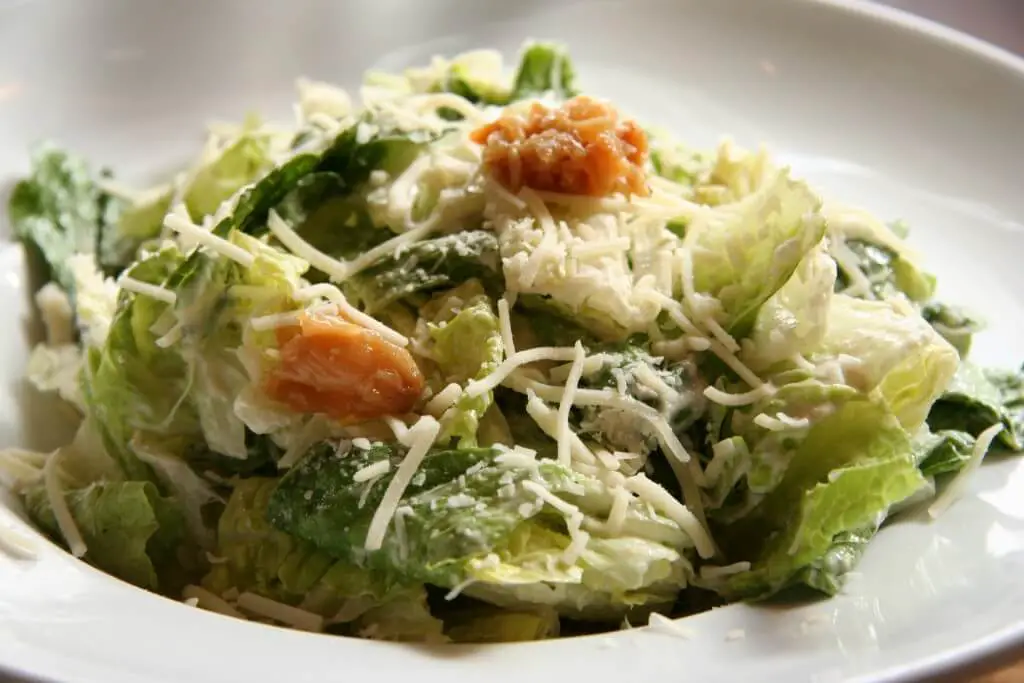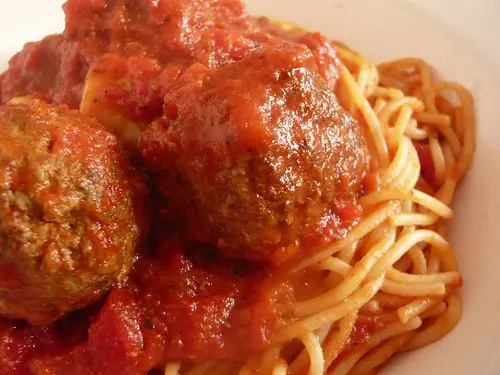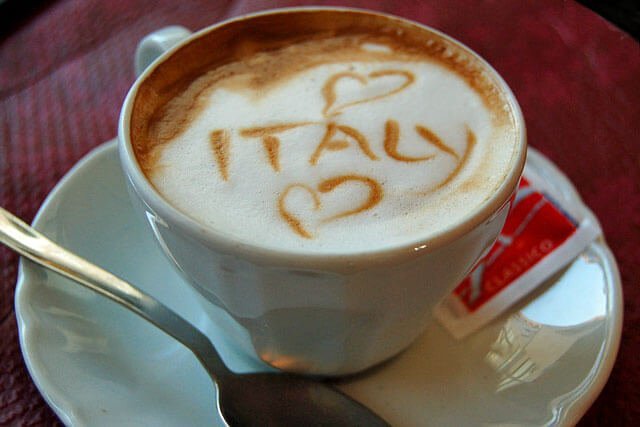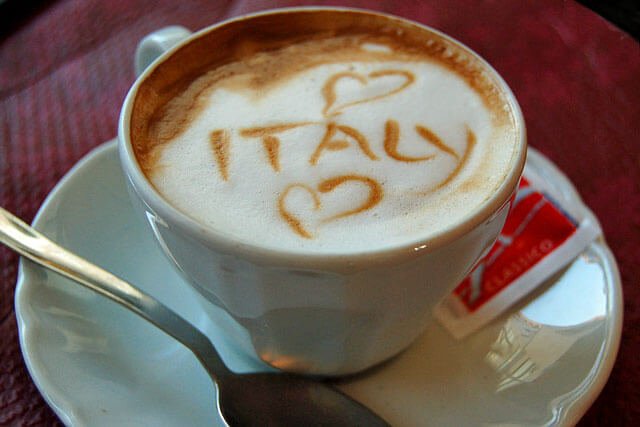The “traditions” behind some of our favorite traditional Italian food favorites aren’t what you think.
Over the years, Italy’s world-famous cuisine has seamlessly entered into U.S. culinary culture thanks to immigration, globalization and Giada De Laurentiis. Still, that stuff you eat at your neighborhood joint or local Little Italy is likely more American than Italian, so before arriving in the boot-shaped country, prepare yourself for a slightly different dining experience.

1. Caesar Salad
With Parmesan cheese and croutons, this salad gives off an air of authenticity, but you won’t find it anywhere in Italy. The popular dish doesn’t pay tribute to the great Roman emperor, but rather immigrant-turned-restaurateur Caesar Cardini, who first tossed it in his Tijuana, Mexico establishment in the 1920s. Instead, a typical side salad in Italy features lettuce, tomato, carrots and sometimes beans, radish or olives, dressed only in oil and vinegar.
2. Spaghetti and Meatballs
Most Italian chefs know how to cook up delicious polpette, meatballs, but they never serve them over spaghetti or under tomato sauce, which is an American invention. In Italy, people separate their pasta and meat courses, with the flavorful and well-seasoned balls often serving as an option for the latter. You can also spot miniature versions in certain soups, such as one made with thistle in the Abruzzo region.

3. Bread and Condiments
Bread undoubtedly plays an important role in Mediterranean mealtime, but one that differs from its American counterpart. While dining in Italy, don’t expect this traditional Italian food favorite to be served with dipping oil or butter. Use the slices or rolls to perform la scarpetta, or wipe up any remaining crumbs and juices to indulge your taste buds one last time. And when ordering a sandwich, ask for a panino rather than a panini, which is an anglicized term made from the Italian plural.
4. Coffee

These beans hold a special place in the hearts of Italians, who consume more than 1 billion pounds of them each year and do so mostly at the bar, foregoing take-out options. Order a caffè, though, and you’ll face a shot of strong, dark brown espresso, the country’s standard in caffeinated beverages. Prefer the lighter, foamy Cappuccino? Beware. Sipping on the warm drink after lunchtime goes against Italy’s unwritten social code.
5. Timing
Italian culture is deeply rooted in enjoying delicious Italian food and friends at the table. Traditional mealtimes come later and last longer. Head to lunch at about 1 p.m., have dinner around 8 p.m., and abandon that American habit of eating in a hurry. One of the true pleasures of visiting Italy is allowing yourself to leisurely work your way through a traditional italian meal (even if you are a vegetarian) : appetizer, first and second courses, side dish, and – if you haven’t burst yet – dessert!
Photo credits: WordRidden and Wikipedia Commons

Well that’s informative!
I didn’t know many of these things, and I do feel kind of foolish for thinking that our authentic Italian food in North America isn’t so authentic after all. I don’t know, I just thought that with such a strong background in Italian immigration, we had some sort of authenticity there. Nope! 😛
Great, great, Briana! What a fun and informative article! Pointing out the changes of food and terminology through cultural adoption is endlessly entertaining. Thanks for posting!
Our preconceived ides of what makes “italian” food will definitely get us in trouble! I knew about Caesar salad and would have guessed about spagetti and meatballs but I did find the article very informative and interesting.
Ciao Briana,
you must mention also Fettuccine Alfredo, Garlic Bread and Chicken Parm, which are all American inventions based on non-existent Italian origin.
I wrote about my “favorite fallacies” HERE
Margo, the new site looks stunning!
Experiencing the food in Italy was certainly the highlight of my trip there. Although I had heard that they frown upon serving cappuccinos after lunch, I never had a problem ordering one. Although the staff probably said, “oh that clueless Americano” behind my back. :-).
the big two differences that I have totally bought into the Italian side are (1) very few ingredients on your pizza and (2) much less sauce on all kinds of pasta. I am a Italian believer now.
Italian is my favorite kind of cooking because of its simplicity. “Less is more” doesn’t seem to jive with the American food mentality… It is our way to add more! Love this article, Briana!
Great article. Love that “authentic” Caesar salad, though. When I teach English abroad, and people ask what American food is like, I usually tell our best food is American Mexican food, American Italian food, and American Chinese food, none of which resemble the authentic cuisine very closely, but all of which are delicious.
Great article, as Italian living in Italy I can say that you are 100% right. And I could add other “fallacies”.
What hurts me more is that Americans change a lot of our recipes and then say our food is not good when dieting. The problem is in those modifications… Italian cousine, if properly made, is perfect to be fit..infact it has been declared Human heritage few years ago as the best way to stay healthy (and happy since it tastes good) 😉
Greets
Lori.
Well we do not soak but we like bread, olive oil, salt and fresh tomatoes. I used to eat it when I was a kid.
And we also prepare bruschette: we roast few minutes a slice of bread on the barbeque, scratch the bread with onions, then pour olive oil and serve it warm.
You may also be surprise that traditionally, in Napoli, there are only 2 or 3 kind of pizza… All the others are just copies…
We were delighted to learn that the “rules” we had been taught were mostly wrong, particularly the one about eating all the courses on the menu. Antipasto, pasta, meat, salad, dessert. We happily skipped a couple of courses, and asked for many pasta and meat courses “per due (doo-ee)”–for two. No extra charge. No frowns form the waiter, and two happy people who didn’t go away stuffed.
Excellent article! Thinking about eating meals “leisurely,” takes me back to some evenings spent in Italy this year.
You could add that Italians don’t put grated cheese on top of a pasta dish made with seafood.
Great fun reading about it! If you want to try the real Italian recipes and find out more about food go to http://www.about-italian-food.com!
You’ll enjoy it!
Ciao from Mario